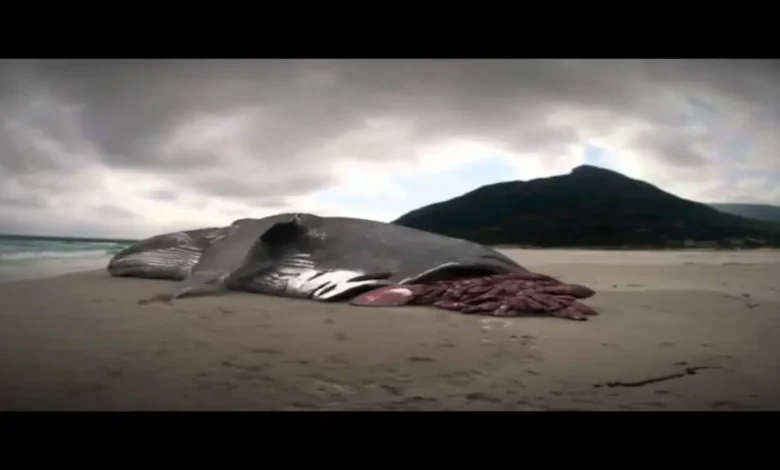Blue Whale Bitten in Half: An In-Depth Look at a Shocking Marine Phenomenon

The Blue Whale Bitten in Half the largest animal ever known to have existed, roams the oceans with a grace and power that has earned it a spot in the Natural World’s Hall of Fame. But even such a majestic creature is not immune to the dangers lurking beneath the waves. One of the most surprising phenomena to emerge from oceanic research is the account of a blue whale being bitten in half. While this sounds like something out of a dramatic nature documentary or a rare occurrence in the world of animal behavior, it’s a topic that has been increasingly discussed by marine biologists, conservationists, and ocean researchers.
In this article, we will explore the details behind the concept of a blue whale being bitten in half, including the potential causes, the creatures involved, and the implications of such an event. We’ll dive into the biology of the blue whale, its predators, and how the oceanic food chain may explain how something as extraordinary as this can occur.
The Blue Whale Bitten in Half: The Giants of the Ocean
The blue whale is undoubtedly a marvel of nature. Growing up to 100 feet long and weighing as much as 200 tons, these marine giants are awe-inspiring in both their size and their place in the natural world. But despite their immense size, blue whales are not without their vulnerabilities, especially in the vast, unpredictable ocean.
The Biology and Life Cycle of Blue Whales
Blue Whale Bitten in Half scientifically known as Balaenoptera musculus, are baleen whales, meaning they filter feed using baleen plates rather than teeth. These enormous creatures consume vast quantities of tiny organisms, such as krill, which make up the majority of their diet. A single adult blue whale can eat up to 4 tons of krill a day during feeding season, diving to depths of over 500 meters in search of their meal.
Their life cycle is equally fascinating, as blue whales can live up to 90 years or more in the wild. They are found in oceans across the globe, from the Arctic to the Antarctic, migrating vast distances between feeding and breeding grounds. Their sheer size and strength have made them nearly indestructible in the minds of many, with only a few predators being able to threaten them.
Blue Whale Vulnerabilities: What Threatens the Giants?
Despite their immense size and strength, Blue Whale Bitten in Half face a variety of threats in the ocean. From human-induced dangers like ship strikes and entanglement in fishing nets to environmental factors such as climate change, these magnificent creatures are far from invulnerable. However, one of the most surprising and lesser-known threats to blue whales is the possibility of being attacked by marine predators—particularly the orca, or killer whale.
Although there are very few documented instances of blue whales being harmed by predators, the nature of the ocean means that many such occurrences may go unnoticed. The ocean’s vastness and the migration habits of Blue Whale Bitten in Half make it difficult for researchers to observe the full spectrum of interactions between these animals and other marine creatures.
The Predator: Killer Whales and Their Fierce Reputation
Killer whales, or orcas, are among the ocean’s most formidable predators. Unlike other whale species, orcas are known for their highly developed hunting techniques and their ability to target and kill prey far larger than themselves, including seals, sharks, and even other whales. This makes the orca one of the only natural predators capable of attacking Blue Whale Bitten in Half.
The Orca’s Hunting Skills
Orcas are apex predators in the ocean, with a sophisticated social structure and an impressive hunting repertoire. They often hunt in pods, using coordinated strategies to corner and overpower prey. When it comes to larger animals like the blue whale, orcas are known to employ complex group tactics to wear down their massive target, focusing on the weaker members of the species, such as calves or injured individuals.
While it is rare for orcas to attack adult blue whales, the possibility exists. These attacks, when they do happen, often involve a group of orcas working together to inflict injuries. This coordinated effort can result in severe wounds, potentially even the death of the whale. In extreme cases, an attack could lead to the whale being bitten in half or suffering fatal damage, though such events are incredibly rare.
The Mechanics of an Orca Attack
Orcas have been observed hunting other marine mammals with a high degree of efficiency. Their powerful jaws and sharp teeth enable them to inflict deep wounds on their prey. When attacking a whale, an orca might target vulnerable areas such as the flippers, tail, or throat, where the whale is less protected by blubber or bone.
However, the idea of a Blue Whale Bitten in Half is not as simple as it might sound. Even with the formidable power of an orca, the blue whale’s massive size presents a significant challenge. The notion of a whale being bitten in half is more likely a result of severe, life-threatening injuries that could lead to its death rather than a direct physical severing of the body.
The Myth of the Blue Whale Bitten in Half
While the notion of a blue whale being bitten in half by an orca or any other predator is captivating, it’s important to clarify the facts surrounding such claims. While there have been reports of blue whales being attacked by orcas, the scenario of one being “bitten in half” is largely a myth or an exaggeration.
Rare but Real: Orca Attacks on Blue Whales

In reality, the number of confirmed attacks on Blue Whale Bitten in Half by orcas is extremely small. Most blue whale attacks are focused on calves, as they are more vulnerable due to their smaller size and lack of strength. Adult blue whales are much harder to take down, and even a pod of orcas would struggle to kill one.
In instances where a blue whale has been severely injured or killed by orcas, the damage might include deep lacerations or internal injuries, but the idea of a whale being bitten in half is not consistent with what we know about orca predation. More often, the orcas’ strategy involves prolonged attacks that weaken the whale over time, potentially leading to its death.
The Role of Human Impact on Blue Whale Survival
Beyond predation, Blue Whale Bitten in Halfface numerous human-made threats that can contribute to their vulnerability in the ocean. Ship strikes, pollution, and the effects of climate change all pose significant risks to these already endangered animals. Changes in ocean temperature and krill populations have affected the food supply for blue whales, making it even more difficult for them to thrive in an increasingly hostile environment.
The conservation efforts to protect Blue Whale Bitten in Half have become more urgent as their populations decline, primarily due to these human-induced threats. Despite the occasional instances of predation from orcas, the biggest danger to blue whales remains the impact humans have on the oceans.
The Myth and the Reality of Marine Life in the Deep Ocean
The idea of a Blue Whale Bitten in Half being bitten in half captures the imagination and paints a dramatic picture of life in the deep ocean. However, it’s essential to look beyond the sensationalized stories and understand the true dynamics of marine life. The ocean is home to complex ecosystems where each creature, from the smallest plankton to the largest whales, plays a crucial role in maintaining balance.
The Importance of Research in Understanding Marine Ecosystems
Much of what we know about Blue Whale Bitten in Half predation comes from years of research, observations, and studies in the field. Marine biologists and researchers use technology such as drones, underwater cameras, and satellite tracking to study the behaviors of marine creatures, including whales and orcas. This research provides valuable insights into how animals interact with each other and helps debunk myths while revealing the more complicated truths of life beneath the waves.
Understanding the role of apex predators like orcas in the ocean’s ecosystem helps clarify their impact on whale populations. While orcas may sometimes prey on Blue Whale Bitten in Half, they are part of a broader web of interactions in the marine world that maintains the health of the ecosystem. The story of the blue whale being bitten in half is not a typical event but rather a rare and complex phenomenon that highlights the intricate relationships among marine creatures.
Conclusion: The Fascinating World of Blue Whales and Orcas
The concept of a blue whale being bitten in half is more a myth than a reality, though it’s rooted in some of the more complex interactions between marine predators like orcas and their prey. Blue Whale Bitten in Half despite their size and strength, are not invulnerable, and the oceans are full of predators capable of preying on the weaker members of their species.
However, it is essential to understand that these events are exceedingly rare, and the vast majority of blue whales continue to live out their lives in the open oceans, where they play a vital role in the ecosystem. The myth of the blue whale bitten in half serves as a reminder of the power and drama of ocean life, but it should not overshadow the importance of protecting these incredible creatures for future generations.
As researchers continue to study the marine world, we gain a better understanding of how life in the ocean works, allowing us to protect and conserve the species that call it home. The reality is that while predation does occur, it’s only one piece of the puzzle in the complex and awe-inspiring world of the ocean.





